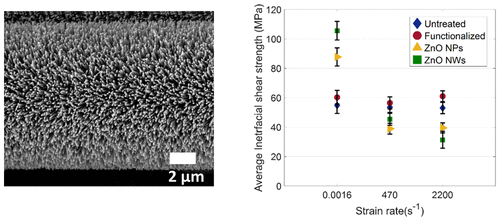当前位置:
X-MOL 学术
›
ACS Appl. Nano Mater.
›
论文详情
Our official English website, www.x-mol.net, welcomes your
feedback! (Note: you will need to create a separate account there.)
ZnO Nanostructured Interphase for Multifunctional and Lightweight Glass Fiber Reinforced Composite Materials under Various Loading Conditions
ACS Applied Nano Materials ( IF 5.3 ) Pub Date : 2020-01-21 , DOI: 10.1021/acsanm.9b02216 Jalal Nasser 1 , Kelsey Steinke 2 , Henry Sodano 1, 2
ACS Applied Nano Materials ( IF 5.3 ) Pub Date : 2020-01-21 , DOI: 10.1021/acsanm.9b02216 Jalal Nasser 1 , Kelsey Steinke 2 , Henry Sodano 1, 2
Affiliation

|
The optimal mechanical performance of glass fiber reinforced epoxy matrix composites typically relies on the suitability of its interfacial properties to the applied loading conditions. The contrasting interfacial requirements for glass fiber composites in ballistic versus structural applications require multicomponent designs that lead to an increase in the system’s weight, cost, and complexity. Thus, interfacial modifications that yield a multifunctional composite performance are necessary to simultaneously yield maximal energy absorption under dynamic loading rates and high resistance to delamination under static loading rates. In this work, a zinc oxide (ZnO) nanostructured interphase is grafted on the surface of glass fibers to enable the tuning of interfacial shear strength (IFSS) in glass fiber reinforced composites (GFRC) for optimal behavior across a large range of strain rates. The glass fibers are functionalized by using a treatment in piranha solution to increase the surface oxygen content and improve the adhesion between the fiber and the ZnO nanostructure. The ZnO nanowires displayed up to 96% improvement in average IFSS relative to untreated fibers at a quasi-static strain rate and a 68% decrease in IFFS compared to untreated fibers at strain rates greater than 2000 s–1. The enhanced average IFSS at static loading conditions is caused by the creation of a functional gradient at the glass fiber–epoxy matrix interface due to the ZnO nanowire interphase, while the decrease in interfacial properties at dynamic loading rates is the result of matrix stiffening, causing brittle fracture of the ceramic interphase. These results demonstrate the potential of integrating ZnO nanomaterials at the fiber–matrix interface to simultaneously introduce ballistic and structural functionality into fiberglass reinforced polymer matrix composites.
中文翻译:

多功能轻质玻璃纤维增强复合材料在不同负载条件下的ZnO纳米结构界面
玻璃纤维增强的环氧基复合材料的最佳机械性能通常取决于其界面特性对所施加的载荷条件的适合性。弹道与结构应用中玻璃纤维复合材料的界面要求不同,需要多组分设计,这会导致系统的重量,成本和复杂性增加。因此,产生多功能复合性能的界面改性对于同时在动态负载率下产生最大的能量吸收和在静态负载率下产生高抗分层性是必需的。在这项工作中 在玻璃纤维的表面接枝了氧化锌(ZnO)纳米结构的相,以调节玻璃纤维增强复合材料(GFRC)中的界面剪切强度(IFSS),以在较大的应变率范围内实现最佳性能。通过在食人鱼溶液中进行处理,使玻璃纤维功能化,以增加表面氧含量并改善纤维与ZnO纳米结构之间的附着力。相对于未处理的光纤,ZnO纳米线在准静态应变率下的平均IFSS最高提高了96%,而在应变率大于2000 s的情况下,IFFS的平均IFSS降低了68%通过在食人鱼溶液中进行处理,使玻璃纤维功能化,以增加表面氧含量并改善纤维与ZnO纳米结构之间的附着力。相对于未处理的光纤,ZnO纳米线在准静态应变率下的平均IFSS最高提高了96%,而在应变率大于2000 s的情况下,IFFS的平均IFSS降低了68%通过在食人鱼溶液中进行处理,使玻璃纤维功能化,以增加表面氧含量并改善纤维与ZnO纳米结构之间的附着力。相对于未处理的光纤,ZnO纳米线在准静态应变率下的平均IFSS最高提高了96%,而在应变率大于2000 s的情况下,IFFS的平均IFSS降低了68%–1。静态负载条件下平均IFSS的提高是由于ZnO纳米线的界面在玻璃纤维-环氧树脂基体界面处形成了功能梯度,而动态负载率时界面性能的下降是基体变硬的结果,导致陶瓷相间脆性断裂。这些结果证明了将ZnO纳米材料整合到纤维-基体界面上的潜力,同时将弹道和结构功能引入玻璃纤维增强的聚合物基复合材料中。
更新日期:2020-01-22
中文翻译:

多功能轻质玻璃纤维增强复合材料在不同负载条件下的ZnO纳米结构界面
玻璃纤维增强的环氧基复合材料的最佳机械性能通常取决于其界面特性对所施加的载荷条件的适合性。弹道与结构应用中玻璃纤维复合材料的界面要求不同,需要多组分设计,这会导致系统的重量,成本和复杂性增加。因此,产生多功能复合性能的界面改性对于同时在动态负载率下产生最大的能量吸收和在静态负载率下产生高抗分层性是必需的。在这项工作中 在玻璃纤维的表面接枝了氧化锌(ZnO)纳米结构的相,以调节玻璃纤维增强复合材料(GFRC)中的界面剪切强度(IFSS),以在较大的应变率范围内实现最佳性能。通过在食人鱼溶液中进行处理,使玻璃纤维功能化,以增加表面氧含量并改善纤维与ZnO纳米结构之间的附着力。相对于未处理的光纤,ZnO纳米线在准静态应变率下的平均IFSS最高提高了96%,而在应变率大于2000 s的情况下,IFFS的平均IFSS降低了68%通过在食人鱼溶液中进行处理,使玻璃纤维功能化,以增加表面氧含量并改善纤维与ZnO纳米结构之间的附着力。相对于未处理的光纤,ZnO纳米线在准静态应变率下的平均IFSS最高提高了96%,而在应变率大于2000 s的情况下,IFFS的平均IFSS降低了68%通过在食人鱼溶液中进行处理,使玻璃纤维功能化,以增加表面氧含量并改善纤维与ZnO纳米结构之间的附着力。相对于未处理的光纤,ZnO纳米线在准静态应变率下的平均IFSS最高提高了96%,而在应变率大于2000 s的情况下,IFFS的平均IFSS降低了68%–1。静态负载条件下平均IFSS的提高是由于ZnO纳米线的界面在玻璃纤维-环氧树脂基体界面处形成了功能梯度,而动态负载率时界面性能的下降是基体变硬的结果,导致陶瓷相间脆性断裂。这些结果证明了将ZnO纳米材料整合到纤维-基体界面上的潜力,同时将弹道和结构功能引入玻璃纤维增强的聚合物基复合材料中。











































 京公网安备 11010802027423号
京公网安备 11010802027423号